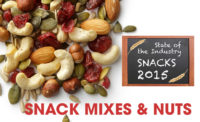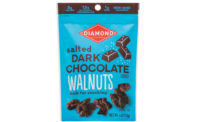Snack mixes offer convenience, nutrition and on-trend flavor: State of the Industry 2016
Snack mixes embody the collective driving force of today’s snack industry—a little something different, packed with innovative flavors and loaded with better-for-you benefits.

courtesy of Kraft Heinz Co.

courtesy of Cherry Marketing Institute

courtesy of Almond Board of California

courtesy of Second Nature

SNACK MIXES & NUTS Sales

SNACK MIXES & NUTS Sales

SNACK MIXES & NUTS Sales







The appeal of snacking continues unabated. According to Jeff Manning, chief marketing officer, Cherry Marketing Institute, Dewitt, MI, consumers are snacking more than ever. He suggests that on-the-go, active consumers are drawn to “a series of bits and pieces” compared to the expense of sitting down as a family or community around a full meal. Increasingly, people seek snacks that bring a good measure of nutrition.
Overview | Chips | Puffed/Extruded Snacks | Popcorn | Snack Mixes & Nuts | Tortilla Chips | Pretzels | Frozen Snacks | Crackers
Snack mixes hit on every major trend in snacking today—nutritious, highly portable, quick and easy to consume and often sporting a range of on-trend flavor profiles to pique interest. Snack mixes and nuts represent a microcosm of snacking overall.
“There is a segmentation of consumers that is getting more and more savvy, and more and more experimental with their food,” says Trip Kadey, culinary director, retail, foodservice, French’s Flavor Ingredients, The French’s Food Company, Chester, NJ.
Snack mixes deliver the basics of all that is right in snacking today—but people also want great-tasting products.
Snack mixes reflect many overall trends taking the food industry by storm. In June, Mintel, Chicago, tapped six emerging trends, many of which align very closely with what snack mixes offer consumers (see “A balancing act: six trends in snacking for 2016”).
First, Mintel highlighted the popularity of fruit- and vegetable-based offerings, specifically those featuring dried and freeze-dried ingredients, as well as chocolate-dipped ingredients. Hybrid snacks like meat trail mix and trail mix cookies were also cited. International flavors were also noted, as were products dubbed “simple and real,” lacking artificial flavors and colors.
These trends, paired with consumers’ desire for grab-and-go customized snackability, are creating a prime market for snack mixes.
Market data
According to data from IRI, Chicago, dollar sales of nutritional snacks/trail mixes grew 5.60 percent in the 52 weeks leading up to April 17, 2016 to reach $1.1 billion. Private label offerings lead the segment and had an up year, growing 6.83 percent and accounting for about half of total dollar sales in the category, hitting $536.4 million. Kar’s Nuts was also up, growing by 7.91 percent to $43.4 million. Second Nature saw strong dollar sales growth of 22.21 percent to $25.8 million. The Hershey Co. likewise saw growth of its Reese’s Snack Mix products (but the reported rate of growth is inflated due to uneven year-to-year comparisons).
The snack nuts segment grew by 3.41 percent in dollar sales to $4.6 billion, per IRI. Again, private label leads the segment, up 4.32 percent to $1.3 billion—but Kraft Foods Group (now Kraft Heinz Co.), with its Planters brand, follows closely behind, up 5.91 percent to $1.3 billion.
Looking back
“The snacking occasion is on fire, and mixes are a big part of that growth,” says Manning. But what is it about mixes that’s so appealing right now?
For one, snack mixes often hit nutritional high notes that many other snacks can’t reach—even when whole-food ingredients like nuts and dried fruits are paired with indulgent ingredients like chocolate.
Manning sees Montmorency tart cherries as a natural fit for snack mix brands due to the fact that it’s a “natural superfruit that adds flavor, texture, and nutrition value to snacking,” he says. “Montmorency tart cherries have been credited with an array of health advantages.” Plus, he notes, they taste great alongside snack mix standbys like nuts, seeds, chocolate and yogurt.
Second Nature—which saw particularly strong growth over the past year—sells a Wholesome Medley mix that includes almonds, cashews, peanuts, cherries, cranberries and dark chocolate. Its Mediterranean Medley features Greek yogurt drops, almonds, dates, cranberries, blueberries and pecans.
Tom Payne, food industry consultant, U.S. Highbush Blueberry Council, Folsom, CA, says dehydrated blueberries make sense in mixes alongside other antioxidant-rich ingredients like walnuts, pecans and dark-chocolate chips. On the production line, formulators can choose from freeze-, microwave- or infused-dried options, during which frozen blueberries are dipped in a warm-water solution and then submerged in sweeteners—such as like juice concentrate or syrup—to infuse sweetness and create a shelf-stable blueberry that makes sense in a mix.
“Consumers are increasingly looking for snacks that pack a mix of protein and fiber,” says Manning, “the nutrients that help people feel fuller longer.” Plant-based proteins like roasted almonds and walnuts, or dried chickpeas and lentils, meet demand, as do seeds like hemp, chia, pepita and flaxseed.
Planters has seen success with its NUT-rition products, many of which call out specific nutrient benefits, as seen in Blueberry Nut Protein Mix featuring honey-roasted peanuts, granola protein clusters, almonds, yogurt-covered raisins and blueberries. The line received a packaging makeover in 2015 in conjunction with a national ad campaign.
Blue Diamond performed well over the past year in the snack nuts segment, up 8.55 percent in dollar sales to $497.6 million, offering a range of international sensations via its Bold Flavors line, including Sriracha, Wasabi & Soy Sauce and Habanero BBQ.
Private label leads the snacks/trail mix category by a wide margin, often due to attractive price points—but also innovation. Target Corp. has maintained consumer appeal for its snack mixes, some of which take on bold flavor profiles, like the Archer Farms Tex Mex, made with spicy peanuts, almonds, salsa corn sticks, sesame sticks, chili bits and pepitas. Its Zen Party mix includes rice crackers, sesame sticks, green peas, almonds, cashews and wasabi peas.
Looking forward
Many snack mix and nut products often include premium ingredients that command a premium price.
“We are looking for snacks to do more than just give us something to eat—we are looking for fuel,” says Kadey. “People are looking for protein and fiber, and a snack that’s going to taste great. With that, a slightly higher price sensitivity is available.”
Consumers’ willingness to try something new, paired with a surge in diverse ingredient combinations on the market, is shaping new trends in mixes. And though millennial shoppers are often credited with demanding spice, Kadey says it’s also generation Z and baby boomers driving this trend. “They’re expecting to excite and engage more senses with flavor, aroma and spice,” he says, noting that it’s not sheer heat they're after, but rather flavors around the spice, “whether it’s a fermented aged cayenne, Hispanic or Asian flavor.”He notes that French’s Flavor Ingredients offers wet and spray dried flavors, as well as products like crispy onions, jalapeños and potato sticks that all work well in a snack mix formulation.
Going forward, dehydrated proteins are on the radar, from jerky to plant-based options, because dehydration is a clean-label preservative that also offers great flavor. “People would rather see something smoked, pickled, dehydrated or freeze-dried than treated with an unnatural preservative,” suggests Kadey. “From jerky and other dried meats to vegetable-proteins, the ones that are less tough and chewy, as well as nutrient-dense, well-seasoned and colorful—those will get the most use.”
In the end, the future looks bright, says Kadey: “Consumers today have a zest for new ideas, are open to spending more and are sharing mixes with others. It’s probably the best time ever to be in the snack mix business.”
Overview | Chips | Puffed/Extruded Snacks | Popcorn | Snack Mixes & Nuts | Tortilla Chips | Pretzels | Frozen Snacks | Crackers
Looking for a reprint of this article?
From high-res PDFs to custom plaques, order your copy today!












